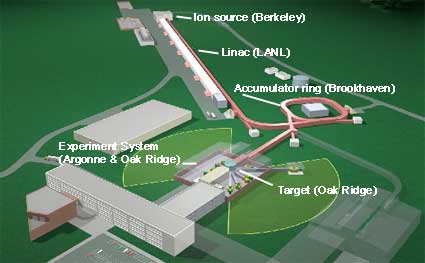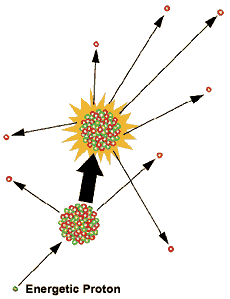|
 The Spallation Neutron Source under construction at Oak Ridge The Spallation Neutron Source under construction at Oak Ridge
BERKELEY, CA — A major milestone in the development of the
Spallation Neutron Source (SNS) -- the accelerator-based facility that
will provide the most intense pulsed-beams of neutrons ever available for
scientific research and industrial development -- has been achieved at
Berkeley Lab.
A startup negative hydrogen ion source and low-energy beam transport (LEBT)
system, the first two components of the SNS "front-end system,"
have been built and are now undergoing commissioning tests. Results so far
could not have been better.
 |

WHEN A HIGH-ENERGY PROTON BOMBARDS A HEAVY ATOMIC NUCLEUS,
CAUSING IT TO BECOME EXCITED, MANY NEUTRONS ARE EXPELLED
|
The SNS project is a collaboration between Berkeley Lab, and Argonne,
Brookhaven, Jefferson, Los Alamos, and Oak Ridge national laboratories.
When construction at Oak Ridge in Tennessee is complete and it goes
on-line (scheduled for the year 2006), the SNS will be capable of
delivering an average of two million watts of neutron beam power onto a
target, more than 10 times the capacity of today's most powerful pulsed
neutron sources. The scattering of these neutrons when they strike
experimental samples will reveal to scientists and engineers the most
intimate structural details of a wide range of materials.
The SNS generates its neutron beams through the combination of a linear
accelerator (linac) and accumulator ring which result in the production of
a pulsed beam of protons, energized to about one billion electrons volts
(1 GeV), that gets smashed 60 times a second into a target of liquid
mercury. This yields a pulsed beam of hot neutrons that is immediately
cooled to room or even lower temperatures and directed into samples for
non-destructive neutron scattering studies.
Each of the collaborating national labs has been delegated a specific
responsibility. Berkeley Lab was made responsible for the front-end system
based on the demonstrated expertise of the Ion Beam Technologies (IBT)
program.
"Having recently consolidated this expertise into a single
program, we were the natural choice to take on this challenge," says
IBT program head, Rick Gough. "No one had ever demonstrated that the
SNS front-end performance requirements could actually be met. A
substantial level of research and development was required, and the
results of these efforts are now paying off."
"We have met the time-schedule and are beating the
requirements," says physicist Rod Keller, senior team leader of the
SNS Front-End Group, which is a part of the IBT program under the
Accelerator and Fusion Research Division.
On April 26, physicist Rainer Thomas and his team fired up their ion
source/LEBT and successfully produced an intense beam of negative hydrogen
ions (peak current of 46-milliamperes) at pulse lengths of 200
microseconds. The beam was measured in a Faraday cup at the end of the
LEBT. Less than two months later, high current pulses of the required one
millisecond length are being routinely achieved.
Says Keller, "Our ion source current exceeds the startup
requirement for neutron production from the SNS facility and is a
significant step towards fulfilling the conditions for full-power
operation."
Ultimately, the SNS front-end system will consist of the ion source and
LEBT, a radio-frequency quadrupole (RFQ) accelerator, and a medium-energy
beam transport (MEBT) system. The goal is to accelerate a beam of negative
hydrogen ions to 2.5 million electron volts (MeV) and deliver it to the
linac. Negative hydrogen ions are utilized in the front-end system and the
linac because they lend themselves to efficient injection into the
accumulator ring. As the beam enters the ring, it passes through a foil
that strips the negative hydrogen ions of their electrons -- converting
them into positively-charged hydrogen ions or protons.
"This charge-exchange injection process is very efficient,"
says Keller, "but it can only be accomplished through the use of
negative ions."
The negative ion source constructed by the SNS Front-End Group is based
on the "volume production" technology first developed by
Berkeley Lab physicist Ka-Ngo Leung as part of the magnetic fusion energy
effort. With this technique, negative ions are produced through atomic
processes taking place within a confined volume of plasma, rather than
through a reaction with a metal surface. When tiny quantities of cesium
are added to the plasma, such sources require less power to produce the
needed density of negative ions and offer long-term, dependable service.
However, because the LEBT is more positively charged than the ion source,
it extracts both negative hydrogen ions and electrons from the plasma.
"A major challenge during the commissioning of the front-end ion
source/LEBT is to find the most effective way to separate the electrons
from the negative hydrogen ions so that only the ions continue to be
transported," says Keller.
The Front-End Group appears to have solved this problem by using a
magnetic field to "kick" the electrons out of the beam, and
tilting the ion source at a small angle (about 3 degrees) relative to the
LEBT in order to compensate for the slight deflection imparted to the
ions.
In addition to accelerating and transporting the negative hydrogen ion
beam, the LEBT is also required to chop the beam into mini-pulses of 645
nanoseconds duration with separations of 300 nanoseconds. This is
necessary to allow the extraction-kicker magnet in the SNS accumulator
ring to rise to its full strength. At that point, the accumulated beam can
then be directed towards the spallation target without spilling the high
energy ions on the vacuum chamber.
Learning how to best manage and operate the LEBT is a major task of the
commissioning effort. Later this year, an RFQ accelerator, designed by
physicist John Staples, will also be added to the system. A production
front-end system, which will include the MEBT, is scheduled to be
installed at Oak Ridge in 2002.
There have been more than 40 contributing members of the SNS Front-End
Group. Other key persons on the project include project manager Ron Yourd,
chief engineer Richard DiGennaro, and lead electrical systems engineer
Alex Ratti, all with the Lab's Engineering Division.
Additional Information:
|


